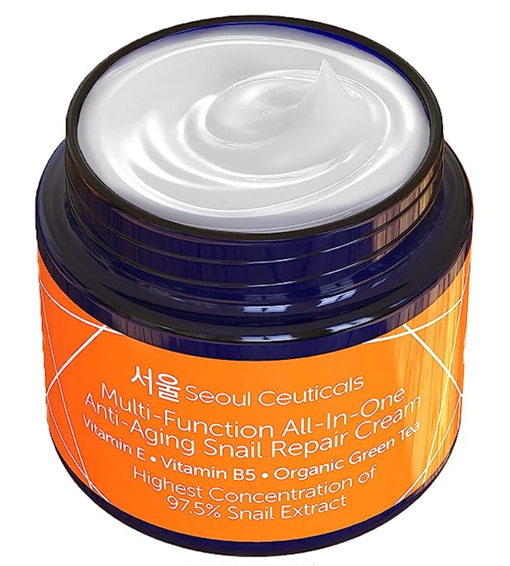Vendors of snail-slime face lotions or creams tout them as some of the best things nature ever invented for everything older and problem skin might need. According to them, snail mucus can fix wrinkles, spots, rosacea, eczema . . . even psoriasis.
I’m not sure about some of the more far-fetched claims, but one thing is for certain: snail mucin (isolated from the giant African snail/Achatina fulica or from other snail species, such as the common garden snail/Cornu aspersum) has a lot going for it. The current hype around it is not for nothing. Lotions and creams with snail mucus may just very well be some of the best skincare products on the market, especially if they contain no parabens, sulfates, or phtalates.
For one, snail mucus contains allantoin, the miracle substance that keeps fixing the snail’s shell when it, too, gets damaged, and also nutrients that stimulate the skin to produce more collagen, which our bodies make less of as we age. Second, it also contains glycolic acid, which is at the forefront of antiwrinkle research these days. Also, aside from boosting collagen production and exfoliating the skin, glycolic acid reduces sun damage and protects the skin from bacteria.
As you may have surmised, by aiding in skin-cell regeneration and functioning as an antibacterial agent, glycolic acid can help with acne. But snail mucin also has antimicrobial proteins (achasin and mytimacin-AF among them) for that.
I have to say I used snail-mucin cream at one point and was very happy with it. Then the shop where I got this face lotion closed and somehow I veered to other facial creams, as I tend to do. But then these days I happened across the old package of my last snail-mucin lotion and decided to look into its properties again, because sometimes I tend to forget things that are good for me (like eating more salads).
Disclaimer: I am not a medical or health practitioner, and no part of This Blog, or the websites and products I mention and link to on This Blog, is intended as professional medical or health advice, and should not be considered as such. Here are my Full Terms and Conditions.
Disclosure: This blog post contains some affiliate links. If you click on (any of) them and make a purchase, they generate revenue for this blog (at no extra cost to you!). As an Amazon Associate I earn from qualifying purchases. All affiliate links on this blog are identified as such. Here’s my Full Disclosure.
Snail mucin also contains copper peptides, which help decrease wrinkles through cellular regeneration and increased production of collagen and elastin. It also contains hyaluronic acid and antioxidant vitamins A and E. It’s quite a powerhouse. Some people use it to dress healing wounds too, which makes sense, given its collagen-boosting and antibacterial properties.
I almost forgot about the chondroitin sulfate. That too, along with some of the other components, has firming, moisturizing, and anti-aging effects.
Now, reading about these benefits online, I’m reminded—and want to remind you—that often what helps our skin is a combination of factors, which may include various skin treatments along with diet and, ouch (for some), giving up smoking. Things like hyperpigmentation and discoloration may benefit from a lotion or cream with glycolic acid, but also from things like vitamin C, because it inhibits the enzyme tyrosinase involved in melanin synthesis. Also, did you know that sugar damages collagen in your body?
So while snail mucin may not be able to help with everything on its own, if you do your research you may find snail mucin can be very helpful in combating acne and other skin problems that you may struggle with.
Please note that if you have an allergy to dust mites or shellfish you’ll also have an allergy to snail mucin, as some allergies are cross-reactive. If you don’t have these allergies but have, perhaps, others and are wary about using snail mucin cream, test it first on a small patch on your arm to see if you get a rash, itching, or other type of allergic response. Be aware that it may also involve respiratory difficulties and in rare cases among those with the above allergies, even anaphylactic shock—so be very careful: you could get tested by an allergist before using snail mucin, to be on the safe side.
That said, for most people snail mucin creams are safe, and they are enjoying great popularity these days.
Here’s one such all-in-one face lotion, a Korean product from COSRX with 16,997 reviews on Amazon so far, 74 percent of them 5-star.
Snail mucin is called here—and often elsewhere in other facial creams or lotions—snail secretion filtrate.

Korean skincare product with 92% snail mucin.
No parabens, sulfates, or phtalates
(affiliate image link)
And here’s another face cream, from Seoul Ceuticals. Their snail repair cream contains 97.5 percent snail extract, with added vitamin E, vitamin B5, and organic green tea.
Korean companies and their skin products have brought the benefits of snail mucus front and center lately, and this snail mucin cream from Seoul Ceuticals seems to have the highest concentration of snail mucus, as it says on the bottle.

97.5 percent snail extract, from Seoul Ceuticals (affiliate image link)
I hope you’ve enjoyed today’s post. If you found it useful in any way, I’d appreciate a pin/share. Thank you!
To a happier, healthier life,
🙂 Mira


